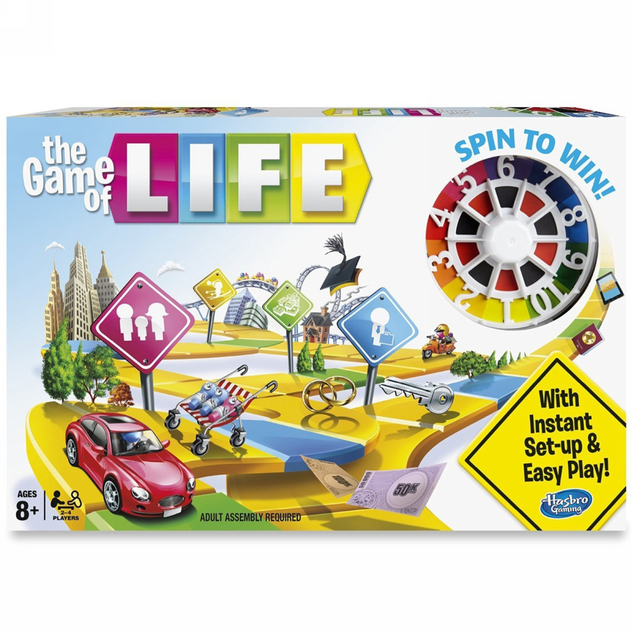
If no player became a Millionaire Tycoon, the one with the highest final total won the game. The player immediately won the game if the chosen number came up, or went to the "Poor Farm" and was eliminated if it did not. The second option was to try to become a "Millionaire Tycoon" by betting everything on one number and spinning the wheel. The first was to continue along the road to "Millionaire Acres," if the player believed they had enough money to out-score all opponents. For example, once a player reached the "Day of Reckoning" space, they had to choose one of two options. The Game of Life, copyrighted by the Milton Bradley Company in 1960, had some differences from later versions. The rules in all different modern versions of the game are generally the same even though they may have different cards and spaces. $500 bills were dropped in the 1980s as were $1,000 bills in 1992. Other tangibles vary between versions of the game. There is also a bank which includes money in $5,000, $10,000, $20,000, $50,000, and $100,000 bills automobile, life, fire, and/or homeowners' insurance policies (depending on the version) $20,000 promissory notes and stock certificates. Each player starts the game with one peg that matches their gender. The modern game pegs are pink and blue to distinguish the genders (blue for male, pink for female). Some "early modern" editions have eight cars. Each car has six holes into which pegs are added as the player "gets married" and "acquires children". A player travels along the track in a small plastic automobile, according to the spins of a small wheel on the board with spaces numbered one through ten. A collaboration between Reuben Klamer and Bill Markham, it consists of a track which passes along, over, and through small mountains, buildings, and other features. In 1960 the modern Game of Life was introduced. Instead of dice – which were associated with gambling – players used a six-sided top called a teetotum. A player could gain 50 points by reaching "Happy Old Age" in the upper-right corner, opposite "Infancy" where one began. The object was to land on "good" spaces and collect 100 points.

The game board resembled a modified checkerboard. Ives in 1843, it had a strong moral message. Like many 19th-century games, such as The Mansion of Happiness by S. The game sold 45,000 copies by the end of its first year. The game was originally created in 1860 by Milton Bradley as The Checkered Game of Life, and was the first game created by Bradley, a successful lithographer. It is now part of the permanent collection of the Smithsonian's National Museum of American History and an inductee into the National Toy Hall of Fame. It was created and co-designed by Bill Markham and Reuben Klamer, respectively, and was "heartily endorsed" by Art Linkletter. The modern version was originally published 100 years later, in 1960. Variations of the game accommodate up to ten players. Up to six players, depending on the version, can participate in a single game. The game simulates a person's travels through their life, from early adulthood to retirement, with college if necessary, jobs, marriage, and possible children along the way. The Game of Life was US's first popular parlour game. The Game of Life, also known simply as Life, is a board game originally created in 1860 by Milton Bradley as The Checkered Game of Life, the first ever board game for his own company, the Milton Bradley Company. High (spinning a wheel, card-drawing, luck) Includes gameboard with spinner, 90 cards (55 Action cards, 20 Career cards, 11 House cards, 4 Invest cards), 4 cars, 36 pegs, money pack, and game guide.Japanese-language version of the modern edition of The Game of Life.Spin to Win is a trademark of The Trustee of the Reuben B. Hasbro Gaming and all related trademarks and logos are trademarks of Hasbro, Inc. It makes an exciting pick for game night or a homeschool activity. Spend cash wisely because the player with the most money at the end of the game wins! The Game of Life game is a fun thing to do while staying at home and a great indoor game for kids ages 8 and up. Action cards give players options for how their adventures play out! Willing to take a risk? Invest in a number on the investment tracker and get more cash whenever someone spins that number. Decide whether or not to get married, grow a family, or retire early. Every Stop! Space is a major life milestone where players spin for their fate or choose their path forward.

Pop in colorful pegs and spin to move along the gameboard as life unfolds from Start to Retirement.

Buckle up for an exciting ride through life's twists and turns.


 0 kommentar(er)
0 kommentar(er)
